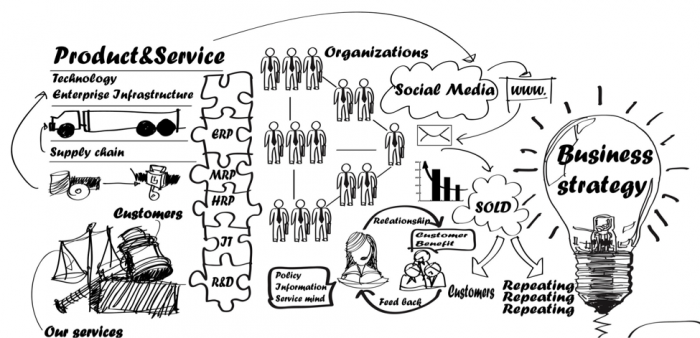Expected results
By performing a process analysis, more systems and procedures are established, thereby increasing efficiency. When people have clearly defined tasks, they naturally better perform job duties, and resources are better utilized.
Establishing transparent processes creates a segregation of duties and reduces the opportunity for fraud. Written job descriptions are a type of process improvement. By creating written roles, jobs can be delegated to the correct person for the task. Written descriptions also allow cross-training for employee vacations, sick leave, terminations, and new hires. Business owners often unintentionally throttle a business by creating bottlenecks. When owners have properly trained staff, they can act as an entrepreneur, creating vision and direction for the business. Process analysis also brings to light unexpected truths, which can be good and bad.
Where the magic happens
Companies are made up of the people and the tasks. They must be in alignment to function efficiently. At each phase, you must understand what the people need to accomplish and how the task needs to be performed to create efficiency.
How is this accomplished? There are several methods that allow you to focus on the details, evaluate the current process, and identify areas for improvement. Creating a process map or value stream mapping can be a time-consuming endeavor. However, this is a benchmarking tool for success. Start with understanding what the core mission of the business is. What do the people do to support the mission?
Sticky notes. I like to start with this high-tech tool … no, really! Performing a sticky note exercise to map out the existing processes is an easy way to depict process flow visually. An excellent book that gives some examples about how best to define each person’s core duties is “Clockwork” by Mike Michalowicz.
Start by gathering the people and have each one explain their primary tasks. Next, create a list of 10 items they must do if the business wants to survive. How much of their daily, weekly, and monthly job do these tasks require? After you have spoken to each team member, compile the results and examine if they are on mission. This is also when you determine whether each step is a value add to the task or a waste of resources. With this, you can evaluate if a process is duplicative, or perhaps creating a constraint in another area.
Process Advisory Q&A with Jonathan Bello
Q. Does your firm offer process advisory services as a bundle with other services, or is it a standalone offering?
A. For new clients, we always perform a client assessment of their processes to get an understanding of how it operates. Then, we can make suggestions for improvements related to QuickBooks, including facilitating apps.
Q. Do you charge for your client assessment?
A. Yes, we have a flat fee assessment, which includes the recommendations. The evaluation does not include other services, such as training or implementations of apps. That is a separate engagement.
Q. How do you explain your assessment to your clients?
A. I explain that the assessment will uncover the bottlenecks and places mistakes are made, and often I have a solution to fix them.
Q. How do you discover their current processes? Do you require all team members to be active in sharing their job descriptions?
A. I have a series of questions. There is an attached comprehensive worksheet Jonathan and I have created and shared.
Q. Since you are mostly doing QuickBooks Process Advisory, how do you set client expectations/timeline for transformation?
A. We relay that it takes time to understand their current processes. After we gather all the details, we create the following:
- Recap of notes
- Process improvement items
- Items to fix (QuickBooks transactions)
- Timeline with agenda and assignments
- Attacking both the processes and items
- After processes and issues are fixed, we suggest Apps which can be introduced
Process Advisors follow this approach to an effective workflow
- Gather business details
- Gather employee details
- Understand why are they seeking help, now?
- Understand the people and the tasks (sticky note exercise)
- Evaluation of the current accounting system and processes
- Deliver assessment
- Employee training
Having an example always helps to paint a picture.
Here is an example of what a Process Advisory engagement could look like for you
A client calls asking for help with a QuickBooks mess. (you grab the Onboarding Assessment Interview Worksheet). He’s not sure what the problem is, but QuickBooks is not accurate and he needs help determining why. You go through the first three sections of the worksheet, asking about the version of QuickBooks, number of employees, type of business, and revenue streams. He is willing to pay you for an evaluation.
First, you meet with the five-office staff and find out three are long-term employees. They asked for help because they are overwhelmed. They know QuickBooks numbers are not up-to-date because they do not have time to perform their duties, but are unsure how to split their positions to accommodate the new staff. The two new staff feel in the way and unsure of their role. You ask them to list out their 10 top job duties on sticky notes, and the amount of time spent on each task. If necessary, you might have them create detailed notes about the steps involved in each of the 10 tasks. You have now completed the fourth section of the worksheet.
Next, you gain access into the QuickBooks file and evaluate the current status and areas for improvement, using the fifth area of the worksheet to keep notes.
Once the evaluation is complete, part of the deliverable would be to list their current processes and then an improved procedure map, using a tool such as SmartDraw, with recommendations for the people and the task. Your recommendation might include one new employee entering payables and the second new employee entering inventory. The senior staff is divided into invoicing and approving payables, while an office manager oversees bank reconciliations. This would conclude the sixth section of the worksheet. Your recommendation for the improved process, including training, would incorporate a timeline and expectations, which is the final phase of the worksheet. You might even suggest implementing integrations.
Additional resources
There are a variety of Process Advisory services that can be explored vertically or horizontally, as you desire, in this market. In my experience with eCommerce clients, they often need help with all aspects of their business, which means I have had to learn about online marketing and sales channels, which include webstores. Because of the time spent learning this industry and my enjoyment dealing with it, I have defined my industry. Other Process Advisors have chosen construction, real estate, manufacturing, or another option. Some might suggest Process Advisory belongs within every engagement. Each time you onboard a client, you are assessing their needs, even if it’s just for a cleanup or ongoing monthly agreement. In order to create a mutually beneficial contract, both parties must have clarity.
These are some of the tools I have found useful along my journey. Sticky notes are a great way to start gathering details. SmartDraw allows me to post the sticky note details in a professional format, which is also a deliverable to the client. A new third-party app on the market is VerifyIQ, which evaluates the condition of your current QuickBooks Online bookkeeping and makes suggestions. Visit Apps.com to check them out. Another app Jonathan Bello and Matthew Fulton recommend is Process Street for workflow management. Here is a link to the Process Street resource Matthew created and graciously agreed to share.
“The Speed of Trust” by Stephen Covey is another excellent book for building organizational trust. I have learned to smell lousy office behavior. If the people working within the environment dislike or distrust each other, bad behaviors are hard to correct. Even with the best workflow and systems in place, an office with mistrust will fail. This is a good book for helping businesses experiencing this reality.
Getting paid. Well.
This is not easy work. It is time consuming, tedious, and often long overdue. When establishing value pricing, variables to consider are plentiful. Be mindful of the depth of your evaluation. Are you simply evaluating their QuickBooks alone, or are you running a full process map of your client’s business? The following should be considered when pricing:
- Number of tasks evaluated
- Number of people evaluated
- Number of years evaluated
- Number of transactions
- Expected deliverables
- Written job descriptions
- Written job processes
- Video tutorials
- Ongoing training
- Ongoing support
- Ongoing engagement
- Length of assessment
Don’t forget change is difficult. You need change management soft skills to keep dialogues open with management and employees. People can get overwhelmed with change, but if you create trust by listening to their concerns and sharing with them the greater vision, you create buy in. Understanding some of the reactions to change is emotional, and people need time to adjust. One phrase I often say is, “Nobody wants to wake up in a whole new world.” The good news for you is this gives you time, which is a resource you need during implementation and training. The lesson is don’t rush.
Process Advisory is often long overdue
Personally, I enjoy assessing the health of the business. It gives me a greater understanding of who I am working with and their business mission. By eliminating the waste, their most precious resource – labor – can be better used to create a streamlined system. It’s exciting when I identify areas of opportunity. This is always a win and builds confidence with my clients.
Even by using Process Advisory to create an outline for the training session, you will build trust with your clients because they will know you understand their workflow and have control over the engagement. Process Advisory is the first step into app consulting. You must first understand the business operations in order to make recommendations for automation. This critical step is often overlooked, which is why many app engagements go wrong.
Process Advisory is an add-on and, for some, a career. Therefore, you should not give these services away or undervalue them. This is value-added work for your client. Often, an assessment has needed to be performed, but put off because of its difficult time-consuming nature. If you are like me and love solving puzzles, you can do this work and be well rewarded.
Read the next article in this series: Apps Advisory.


